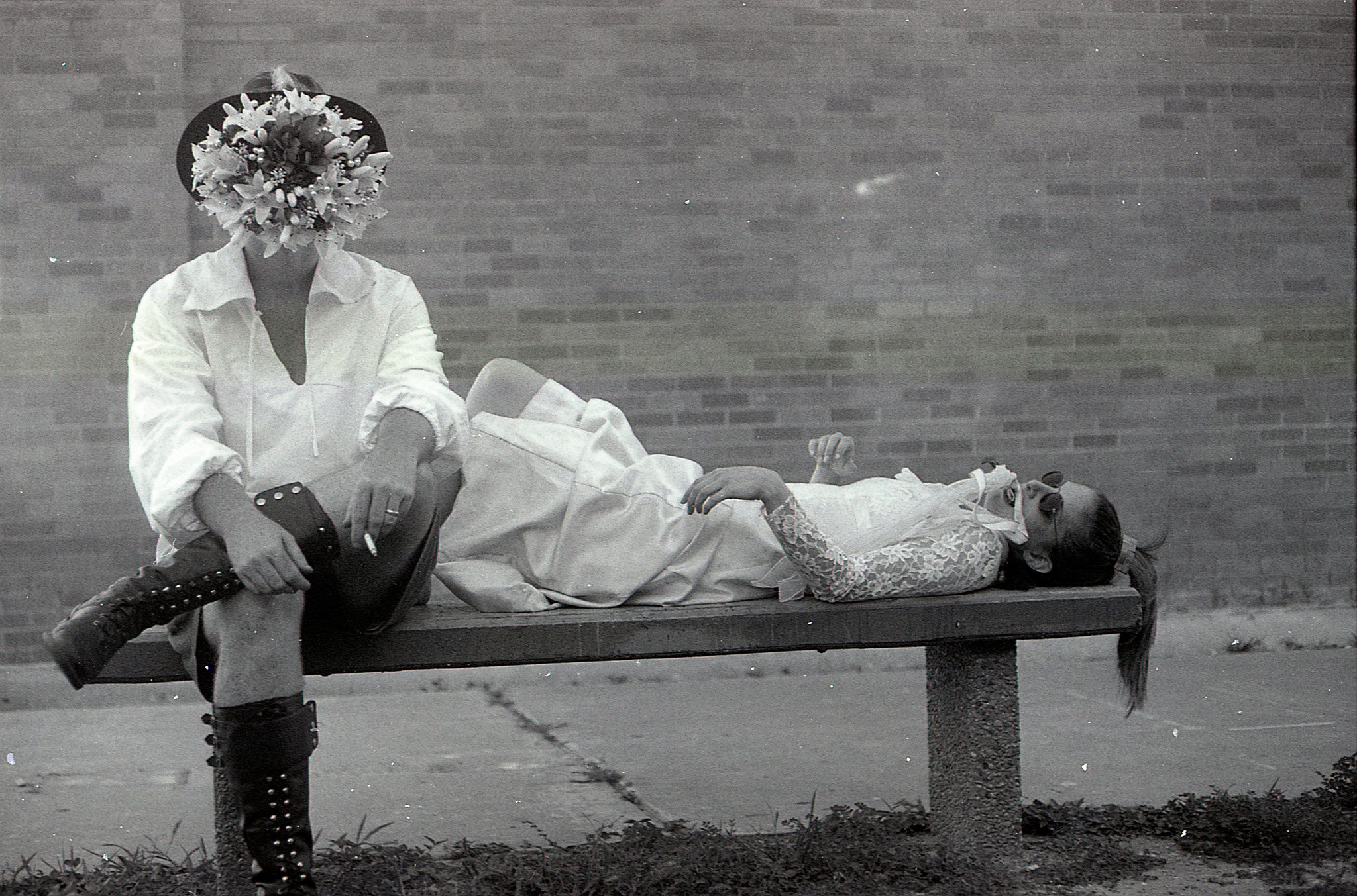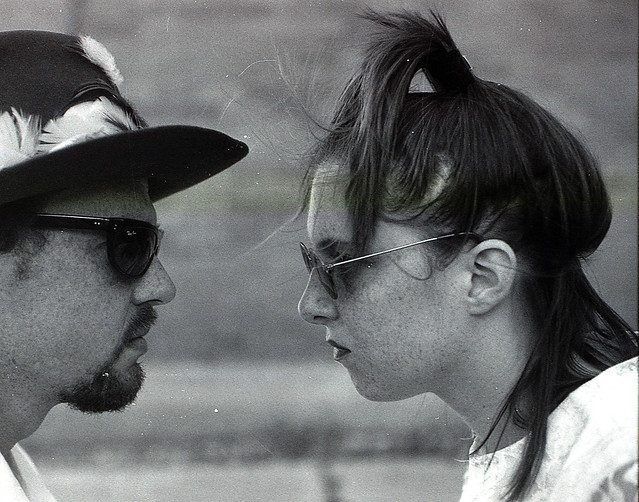

curst & Shrewd: the Taming of the Shrew Unhinged
conceived & directed by shawn sides | adaptation and original text from the cast and kirk lynn
A note from the dramaturg: The collaborative adaptation of Shakespeare’s The Taming of the Shrew, filtered through the agendas of the cast and Shawn’s immense vision, attracting ideas and texts along the way from each persons daily lives, mixing in eleven personal performance pieces, and allowing the whole thing to interact as a text with the world of visual display and audio input, was a pain in everyone’s ass. We collected texts from the cast at a number of reading rehearsals, each reading reminding someone of some text they had read last week in the newspaper or twelve years ago in college all of which they promised to bring to the next rehearsal. Shawn also cultivated each member of the cast as an author in their own right, giving them encouragement and a platform for their own words. It’s a big stack of paper we squeezed into these two hours. I wrote little scraps to loosely tie some of the material together. The script is arranged to be as linear and as thematic as the material allowed, which is not much. Perhaps the best way to put it is a quote from the play, “We have taken all things Kate and placed them in Kate, likewise with Petruchio, though not in that order.” – Kirk Lynn A note from the director: THE SCOLD’S BRIDLE. On the front cover of the playbill was a picture of a scold’s bridle. In Shakespeare’s era, this instrument was used to punish/control ‘unruly women’ – women who complained too loudly, too often, or who disturbed the peace by rebelling against their husbands. Shrews. The following description comes from the Chester Archaeological and Historic Society Journal, 2 (1855-62).* “Contrived with hinged joints, as to admit of being readily adapted to the head of the scold, it was generally supplied with several connecting staples, so as to suit heads of different sizes, and was secured by a padlock. Affixed to the inner portion of the hoop was a piece of metal, which, when the instrument was properly fitted, pressed the tongue down, and effectually branked or bridled it. The length of the mouthpiece or gag varied from 1 1/2 inch to 3 inches, if more than 2 1/2 inches, the punishment would be much increased, as, granting that the instrument was fitted moderately tight, it would not only arrest the action of the tongue, but also excite distressing symptoms of sickness, more especially if the wearer became at all unruly. The form of the gag was very diversified, the most simple being a mere flat piece of iron; in some the extremity was turned upwards, in others downwards; on many of the specimens both surfaces were covered with rasp-like elevations. A staple usually existed at the back part of the instrument, to which was attached a short chain terminating in an iron ring; any additional length required was supplied by a rope. Wearing this effectual curb on her tongue, the silenced scold was either lead through the streets or was sometimes fastened to a post in some conspicuous portion of the town generally the market-place.” Centuries after the scold’s bridle had been abandoned as a barbaric treatment of Englshs shrews, England’s cultural heirs in the States still found it quite useful in the control of unruly slaves. SHREWS. “Shrew-taming” was a common practice in Shakespeare’s time, but Kate’s treatment in the Taming of the Shrew excited repulsion, even in the Elizabethans. No one likes to see the ugly parts of their culture trotted out on the stage. Theatre has that power. The power to magnify the warts and sores of society to take a hard look at what is usually invisible, what seems ‘natural.’ Perhaps that was Shakespeare’s intention all along – to show the Elizabethans their own sores and warts. Or maybe he was just an Elizabethan with an Elizabethan world-view writing what, to them, was a comedy. We can’t really expect more than that from him. Regardless, his intentions don’t really matter. He’s dead. What does matter – to me – is that every production of this play that I’ve seen tries to rescue Kate and Petruchio from what their words say. And in questionable fashion. Does it really make it all okay if Petruchio is simply teaching Kate to “play” her proper role as a woman? If he falls to his knees with gratitude in response to her final speech, should we forgive him for the emotional and physical abuse he heaps on her in the taming process? Will they ride off into the sunset together – equals? What exactly is the difference between “playing” your cultural role as a woman (or as a man for that matter, or as a servant, or a boss, or a “person of color”, or a married person, or an actor) and living that role? Can you be tamed publicly but a shrew in private? If so, is that good enough? Luckily, our culture has come to view rigid behavioral strictures as old-fashioned and Draconian. Things are much better now. *quoted from Boose, Lynda E. “Scolding Brides and Brdling Scolds: Taming the Woman’s Unruly Member” Shakespeare Quarterly 199 , p. 207. Creation Support: This play received no private foundation or government support. Thank you, arts patrons! “..intelligent and inventive, ranging over a deliriously broad range of source material…” — Robert Faires, The Austin Chronicle Won “Outstanding Supporting Actress in a Comedy” – The 1997 Austin Critics’ Table Awards Won “Outstanding Featured Actor” – The 1998 B. Iden Payn Awards Nominated for “Outstanding Original Adaptation” – The 1997 Austin Critics’ Table Awards Nominated for “Outstanding Original Script” and “Outstanding Featured Actor” – The 1998 B. Iden Payne Awards August 14 – September 6, 1997 at Hyde Park Theater PRODUCTION TEAM director Shawn Sides assistant director Jennifer Spohrer dramaturg Kirk Lynn sound designer Kevin Freedman (operator Jennifer Spohrer) video designer Michael Mergen running crew chief Kurt Kern running crew John Botti, Jeremy Edwards costume construction Kathryn Blackbird, Amy Miley, Sarah Richardson lighting Robert Pierson, Lana Lesley light operator Anne Engelking ENSEMBLE Dr. Narrator Lana Lesley Lord Ehren Christian Petruchio Gavin Mundy Kate Kathryn Blackbird, Kristin Johnson, Kirsten “Stan” Kern, Amy Miley, Sarah Richardson Hortensio/Biondello Jason Phillips Grumio José Hernandez Gremio Robert Pierson SETTING Ok, so it’s real late-eighties post-modern but we couldn’t afford a set designer, or a set for that matter, so get off our backs. It kind of fits the show anyway. Minimalism. Dig it. MOVEMENT BREAKDOWN Movement 1. Fie, Fie – “Don’t try and follow the plot or you’ll be sad.” Movement 2. Induction – “I will practice on this drunken man.” Jason Movement 3. Guyness/The Board Room – “Fear boys with bugs.” Ehren Movement 4. Chickness/The Salon – “”What’s Martha doing?” Amy The Rules Movement 5. The Wooing Scene – “Upon Sunday is the wedding day.” Lana Men are from Mars/Women are from Venus Movement 6. Back to the Boardroom – “Play the tape, Michael.” (you can access your very own mail order bride via the internet at www.gosonora.com) Kathy Movement 7. Goin’ to the Chapel – “She is my goods.” Mutual of Omaha’s Wild Kingdom INTERMISSION Movement 8. Servant Hell – “Will you give thanks, sweet Kate, or else shall I?” Jose Movement 9. Married Life – “This is away to kill a wife with kindness.” Stan Movement 10. Fashion – “Put rings upon her fingers.” Sarah Movement 11. Training – “Click snack!” Name that Shrew Gavin Sojourner Truth Movement 12. (Mis)Taken Identity – “Is that a microphone or are you just happy to see me?” Kristin Movement 13. Luau – “He that is giddy thinks the world turns round.” “Fie, fie” Robert Our special thanks to: Patrick Aziz for those fabulous cows, Gavin Mundy & Travis High School for the best rehearsal space in Austin, Marit Mundy for schlepping on demand, Ann Woodall for photographic artistry, Leslie Bonnell for her sewing prowess and her time and her stuff and her wonderful self; Brad Wilson for not screening our calls, Mark Greene for guerilla Photoshop lessons, Mark Lovell for the muddy road we didn’t travel, Jon Watson for his organizational zeal, all of our box and house volunteers – thank god for you, Jason Phelps for his big booming voice, Jayne Noble for the instrument of torture, Sean Hill for a multitude of office goodies, Ty Baker for making sure the monitors won’t fall on our heads, Shannon Sefcik for scanning in the dead of night, Frank Richardson for giving up his favorite slippers, Zachary Scott Theatre, Frontera @ Hyde Park for sharing their space and cheering us on, and Colonial Shakespeare Company for the perfect brown chairs.Reviews:
Awards / Citations:

